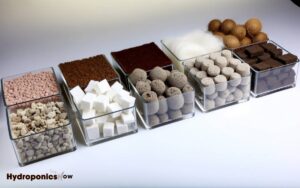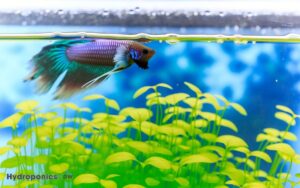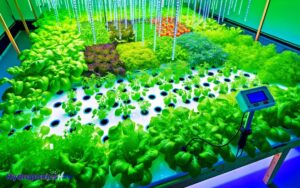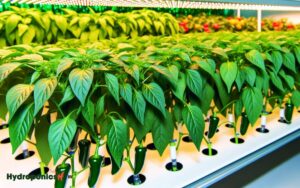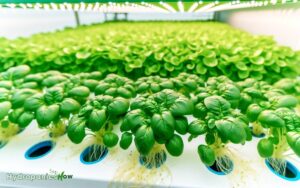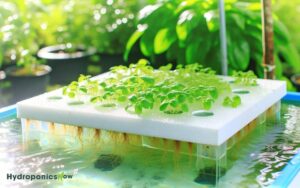What Type of Light Is Used for Hydroponics? Optimal Choices!
Hydroponic systems utilize various specialized lighting options, including LED, fluorescent, HID, HPS, CFL, plasma, and induction lights.
- LED lights offer energy efficiency and customizable spectra. Fluorescent lights balance efficiency and light spectrum quality, ideal for vegetative growth due to high blue light output.
- HID lights provide high lumen output with MH lamps for vegetative stages and HPS for flowering.
- Plasma and induction lights simulate natural sunlight, promoting robust growth through full-spectrum emission.
Each type has unique benefits that optimize plant health and yield. Explore more to discover the specific advantages each light type offers in hydroponic systems.

Key Takeaways
LED Lights
LED lights have become the preferred choice in hydroponics due to their energy efficiency, customizable spectrum, and long lifespan.
The diodes in LED systems convert electricity into light with minimal heat production, optimizing energy consumption and reducing cooling requirements.
Customizable light spectra enable growers to tailor wavelengths to specific plant growth stages, enhancing photosynthesis and biomass accumulation.
Evidence indicates LED lights can achieve a photosynthetic photon flux density (PPFD) that rivals or surpasses traditional lighting, ensuring robust plant development.
Additionally, LEDs exhibit a lifespan exceeding 50,000 hours, minimizing maintenance and replacement costs.
These attributes make LEDs a superior lighting solution, contributing to sustainable and effective hydroponic farming practices.
Fluorescent Lights
Fluorescent lights, commonly utilized in hydroponic systems, offer a balance of energy efficiency and light spectrum quality, which is essential for ideal plant growth.
These lights emit a broad spectrum of light that closely mimics natural sunlight, making them suitable for various stages of plant development.
Additionally, their cost-effectiveness makes them an attractive option for both hobbyist and commercial growers, providing substantial long-term savings.
Energy Efficiency
When evaluating energy efficiency in hydroponic systems, one must consider that fluorescent lights, while traditionally popular, offer a specific lumen-to-watt ratio that influences overall operational costs.
Fluorescent lights, such as T5 and CFL, typically produce between 50 to 100 lumens per watt. This efficiency metric directly impacts electricity consumption and, by extension, the cost-effectiveness of the hydroponic setup.
Despite their relatively lower energy efficiency compared to modern alternatives like LED lights, fluorescent lights are still favored for their affordability and adequate performance in smaller-scale operations.
However, it is essential to weigh these benefits against potential long-term costs associated with higher energy usage and shorter lifespan, necessitating periodic bulb replacements and increased maintenance efforts.
Light Spectrum Quality
When evaluating the light spectrum quality of fluorescent lights for hydroponic systems, it is important to understand that these lights primarily emit light in the blue and red wavelengths, which are essential for photosynthesis and plant growth.
Fluorescent lights are particularly effective during the vegetative stage due to their high blue light output, which promotes robust leaf development and stem strength.
The table below outlines the spectral characteristics of common fluorescent light types used in hydroponics:
| Light Type | Dominant Wavelengths (nm) |
|---|---|
| Cool White | 400-700 |
| Warm White | 500-700 |
| Daylight | 400-700 |
| Gro-Lux | 430, 650 |
| Full Spectrum | 400-700 |
These spectral characteristics guarantee that plants receive the necessary light quality for optimal growth.
Cost-Effectiveness
Evaluating the cost-effectiveness of fluorescent lights in hydroponic systems requires a thorough analysis of both initial investment and long-term operating expenses. Additionally, factors such as energy consumption, bulb lifespan, and the specific light spectrum required for plant growth must be considered. Since hydroponic systems rely on nutrient-rich water instead of soil, understanding how much water hydroponics needs is essential for optimizing both resource usage and overall efficiency. By carefully weighing these elements, growers can determine whether fluorescent lights provide the best balance of performance and affordability for their setup.
Fluorescent lighting offers several advantages that contribute to its cost-effectiveness:
- Initial Cost: Fluorescent lights typically have a lower upfront cost compared to other types such as LED or HID systems.
- Energy Efficiency: While not as efficient as LEDs, fluorescent lights consume less electricity than traditional incandescent bulbs, reducing operational costs.
- Lifespan: These lights generally have a moderate lifespan, balancing replacement frequency and associated costs.
- Heat Emission: Low heat output minimizes additional cooling expenses, which can be substantial in hydroponic setups.
Understanding these factors provides a comprehensive view of the economic viability of fluorescent lighting in hydroponic applications.
High-Intensity Discharge (HID) Lamps
High-Intensity Discharge (HID) lamps, including Metal Halide (MH) and High-Pressure Sodium (HPS) variants, are renowned for their high lumen output and spectral efficiency, which are critical for plant growth in hydroponic systems.
These lamps offer significant advantages such as robust light penetration and a broad spectrum conducive to photosynthesis, though they also present drawbacks including high energy consumption and substantial heat generation.
Understanding the specific characteristics, benefits, and limitations of each HID type is essential for optimizing hydroponic lighting strategies.
Types of HID Lamps
Among the types of HID lamps used in hydroponics, Metal Halide (MH) and High-Pressure Sodium (HPS) lamps are the most prevalent due to their specific spectral outputs and efficacy in promoting plant growth.
MH lamps emit light in the blue spectrum, which is vital for vegetative growth stages, while HPS lamps provide light in the red and orange spectrum, essential for flowering and fruiting phases. These lamps are favored for their high luminous efficacy and penetration.
- Metal Halide (MH): Ideal for vegetative growth with 5,500 to 6,500 Kelvin temperature.
- High-Pressure Sodium (HPS): Effective for flowering with 2,000 to 2,700 Kelvin temperature.
- Conversion Bulbs: Allow switching between MH and HPS in a single fixture.
- Double-ended HPS: Offers more uniform light distribution and higher PAR (Photosynthetically Active Radiation) values.
HID Benefits and Drawbacks
HID lamps offer several advantages such as high luminous efficacy, deep light penetration, and a broad spectrum of light, which collectively enhance plant growth in hydroponic systems.
Their robust performance supports photosynthetic processes, leading to vigorous vegetative and flowering stages. However, drawbacks include high energy consumption and substantial heat output, necessitating efficient cooling systems to mitigate thermal stress.
Additionally, the shorter lifespan and higher replacement costs compared to LED alternatives can affect long-term operational budgets.
| Benefit | Description | Emotion Evoked |
|---|---|---|
| High Luminous Efficacy | Efficient light production per watt | Efficiency |
| Deep Light Penetration | Reaches lower canopy layers | Comprehensive growth |
| Broad Spectrum | Supports all growth stages | Versatility |
| High Energy Consumption | Increases operational costs | Concern |
Evaluating these factors is important for optimizing hydroponic lighting strategies.
Metal Halide (MH) Lamps
Metal Halide (MH) lamps, characterized by their high luminous efficacy and broad spectrum output, are pivotal in hydroponic systems for promoting vigorous vegetative growth.
These lamps emit light that closely mimics natural daylight, essential for photosynthesis and chlorophyll production.
Their effectiveness is bolstered by several key attributes:
- Spectral Quality: MH lamps provide a spectrum rich in blue wavelengths, essential for vegetative development.
- Photon Flux Density (PFD): High PFD levels guarantee adequate light penetration and canopy coverage.
- Efficiency: Despite higher energy consumption, their superior luminous efficiency translates to robust plant growth.
- Longevity: Typically, MH lamps maintain spectral integrity for approximately 10,000-15,000 operational hours.
This combination of spectral quality and performance makes MH lamps indispensable during the vegetative phase in hydroponic cultivation.
High-Pressure Sodium (HPS) Lamps
High-Pressure Sodium (HPS) lamps are a staple in hydroponic systems due to their efficient light spectrum, which mainly emits in the red and orange wavelengths ideal for the flowering stage of plant growth.
With high lumens output, HPS lamps guarantee robust light penetration, promoting dense bud formation and increased yield.
The spectral output and intensity of HPS lamps make them particularly advantageous during the critical flowering phase, enhancing photosynthetic rates and optimizing crop productivity.
Efficient Light Spectrum
Among the various lighting technologies employed in hydroponics, High-Pressure Sodium (HPS) lamps are renowned for their efficient light spectrum, particularly in the red and yellow wavelengths, which are essential for enhancing flowering and fruiting stages.
This optimized spectrum fosters robust plant growth by promoting photosynthetic activity and enhancing chlorophyll production.
Key benefits of HPS lamps’ light spectrum include:
- Red and Yellow Wavelengths: Essential for stimulating flowering and fruiting phases.
- Photosynthetic Efficiency: Maximizes energy conversion in plants, leading to faster growth.
- Chlorophyll Absorption: Enhances chlorophyll efficiency, essential for photosynthesis.
- Penetration Depth: Guarantees light reaches deeper into plant canopies, supporting lower foliage.
These attributes make HPS lamps a preferred choice for hydroponic systems focused on maximized yield and plant health.
High Lumens Output
Renowned for their high lumens output, HPS lamps deliver intense illumination that greatly enhances photosynthetic activity and plant growth in hydroponic systems.
These lamps emit light in the 560-600 nm range, mainly within the yellow-red spectrum, which is ideal for chlorophyll absorption.
With lumen outputs often exceeding 100 lumens per watt, HPS lamps provide efficient energy-to-light conversion, making them a cost-effective option for large-scale hydroponic setups.
Additionally, their high-intensity discharge (HID) technology guarantees deep canopy penetration, fostering robust vegetative growth.
Studies have shown that plants exposed to HPS lighting exhibit accelerated growth rates and higher biomass accumulation compared to other light sources, underscoring the effectiveness of HPS lamps in hydroponic cultivation.
Flowering Stage Benefits
Frequently lauded for their efficacy, HPS lamps are particularly advantageous during the flowering stage of plant development due to their ability to emit light within the ideal red spectrum (620-720 nm), which is essential for promoting bud formation and increasing flower yield.
This spectral output optimizes photosynthetic activity and phytochrome-mediated responses, leading to more robust floral development.
Key benefits include:
- Enhanced Bud Density: Higher light intensity and ideal red wavelengths contribute to denser and more substantial buds.
- Increased Flower Yield: The red spectrum enhances flowering hormones, resulting in a greater number of blooms.
- Energy Efficiency: HPS lamps offer high luminous efficacy, making them cost-effective for extensive flowering periods.
- Proven Reliability: Decades of use in commercial horticulture validate their performance and consistency.
These attributes underscore their continued relevance in advanced hydroponic systems.
Compact Fluorescent Lamps (CFL)
Compact Fluorescent Lamps (CFL) are an energy-efficient lighting option for hydroponic systems, offering a broad spectrum of light that supports various stages of plant growth.
These lamps emit light in the blue and red wavelengths, which are essential for both vegetative and flowering phases.
CFLs produce minimal heat, reducing the risk of thermal stress on plants while enabling closer placement to the canopy for ideal light intensity.
Their efficiency is underscored by lower electricity consumption compared to traditional incandescent bulbs, making them cost-effective. Additionally, CFLs have a longer lifespan, contributing to reduced maintenance needs.
Studies indicate that CFLs can effectively support photosynthesis, enhancing chlorophyll synthesis and overall plant health in hydroponic environments.
Plasma Grow Lights
Plasma grow lights, leveraging advanced gas discharge technology, offer a full-spectrum light source that closely mimics natural sunlight, making them highly effective for hydroponic plant cultivation.
These lights are known for their high photon flux density, which guarantees robust plant growth and improved yield. The inherent efficiency of plasma lights results in lower operational costs and reduced heat output, minimizing the risk of thermal stress on plants.
- Full-spectrum emission: Provides all wavelengths necessary for various growth stages.
- High photon flux density: Guarantees excellent photosynthetic efficiency.
- Lower heat emission: Reduces cooling requirements and prevents plant damage.
- Long lifespan: Offers durability and cost-effectiveness over time.
These attributes collectively make plasma grow lights a compelling choice for hydroponic systems.
Induction Grow Lights
Induction grow lights, utilizing electromagnetic fields to generate light without electrodes, offer a highly efficient and long-lasting lighting solution for hydroponic systems.
These lights operate by exciting mercury vapor within a closed loop, producing ultraviolet (UV) light that interacts with a phosphor coating to emit visible light.
This technology eliminates the degradation of electrodes, resulting in an extended lifespan of up to 100,000 hours. The spectral output of induction grow lights is customizable, aligning with the specific photosynthetic needs of plants.
Studies indicate that their broad-spectrum emission supports robust plant growth and flowering.
Additionally, their low heat output minimizes thermal stress, allowing closer placement to plants. Overall, induction grow lights provide a reliable, energy-efficient option for modern hydroponic cultivation.
Full-Spectrum Lights
Expanding on the benefits of induction grow lights, full-spectrum lights provide a more thorough lighting solution by mimicking the natural sunlight spectrum to optimize photosynthesis and overall plant health.
These lights contain a balanced range of wavelengths from ultraviolet to infrared, promoting robust growth and development.
Full-spectrum lights are particularly effective in hydroponic systems due to their ability to:
- Enhance chlorophyll production, thereby improving energy absorption.
- Support photomorphogenesis, facilitating the formation of roots, stems, and leaves.
- Increase the production of essential oils and secondary metabolites in plants.
- Minimize plant stress by delivering consistent light quality throughout growth cycles.
Research indicates that full-spectrum lighting fosters healthier plants, leading to higher yields and better-quality produce, making it a valuable investment for hydroponic enthusiasts.
Blue Spectrum Lights
Blue spectrum lights play a crucial role in hydroponic systems by driving vegetative growth and enhancing leaf development through their targeted wavelength range.
Specifically, blue light falls within the 400-500 nanometer range, which is vital for chlorophyll absorption and photosynthesis efficiency.
Empirical studies have shown that blue light promotes robust stem growth, compact plant structure, and increased leaf area, which are essential for maximizing photosynthetic capacity.
Additionally, blue spectrum lighting regulates stomatal opening, optimizing gas exchange and nutrient uptake.
Utilizing blue LED lights, which provide precise wavelength control and energy efficiency, can greatly improve plant health and growth rates in hydroponic systems.
Therefore, incorporating blue spectrum lights is essential for achieving optimal vegetative development in controlled-environment agriculture.
Red Spectrum Lights
Red spectrum lights, typically falling within the 600-700 nanometer range, are integral to promoting flowering, fruiting, and overall reproductive growth in hydroponic systems.
This spectrum is essential because it influences phytochrome-mediated processes important for plant development. Research indicates that red light enhances photosynthetic efficiency and drives energy-intensive processes like carbohydrate synthesis.
- Enhanced Flowering: Facilitates the shift from vegetative growth to reproductive stages, promoting robust flower development.
- Improved Fruiting: Stimulates fruit set and maturation by activating key growth hormones.
- Phytochrome Activation: Regulates gene expression related to plant growth and circadian rhythms.
- Carbohydrate Synthesis: Boosts the production of sugars and starches essential for energy storage.
Incorporating red spectrum lights can greatly optimize yield and quality in hydroponic crops.
Light Distance and Placement
Ideal light distance and strategic placement are crucial in hydroponic systems to guarantee consistent light distribution and prevent photoinhibition.
The ideal distance between light sources and plants varies based on the type of lighting used. For example, high-intensity discharge (HID) lights typically require placement 24-36 inches above the canopy to avoid thermal stress and light burn.
In contrast, light-emitting diodes (LEDs) can be positioned closer, around 12-18 inches, due to their lower heat emission and focused light spectrum.
Empirical studies reveal that improper light placement can lead to uneven growth, reduced photosynthetic efficiency, and wasted energy.
Utilizing adjustable light fixtures and regular light intensity measurements ensures an optimal photon flux density (PPFD) and sustainable plant growth in hydroponic environments.
Conclusion
To sum up, the selection of lighting for hydroponics—whether LED, fluorescent, HID, MH, HPS, full-spectrum, blue spectrum, or red spectrum—plays a pivotal role in plant growth and yield.
The intricate dance between light type, spectrum, and placement creates an environment where plants can thrive, akin to an artist meticulously crafting a masterpiece.
Understanding these lighting options and their specific applications offers cultivators the tools needed to foster robust and healthy plant development, ultimately ensuring agricultural success.

